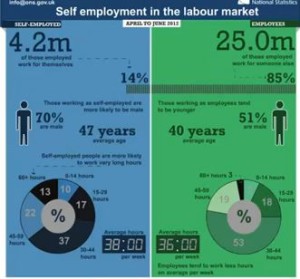The number of workers who are self-employed in their main job rose 367,000 between 2008 – the start of the economic downturn – and 2012, a new report from ONS shows today.
 This rise has mainly been since 2011: of the 367,000 increase in self-employment, 219,000, or 60%, was between 2011 and 2012.
This rise has mainly been since 2011: of the 367,000 increase in self-employment, 219,000, or 60%, was between 2011 and 2012.
By contrast, the number of employees, which fell 434,000 between 2008 and 2012, dropped mainly at the beginning of the period, with a drop of 600,000 between 2008 and 2009, with a partial recovery since 2010.
The increase in self-employment took place across all parts of the UK, with the exception of Northern Ireland, where the number of self-employed workers decreased.
There was an increase of 431,000 over that period in the number of self-employed people who worked on their own or with a partner, but a drop of 66,000 in the number of self-employed workers who had employees working for them.
Today’s report shows that self-employed people work longer hours than employees – on average 38 hours a week compared with 36 for employees.
Self-employed workers tend to be older than employees and are more likely to be male – in 2012 the average age of the 4.2 million self-employed was 47, and 70% of them were men, while the average age of the 25.0 million employees was 40 and only 51% of them were men.
The four most common occupations for self-employment were taxi or cab drivers (166,000), ‘other construction trades’ (161,000), carpenters and joiners (140,000) and farmers (123,000). Some 58% of self-employed people used their home for work purposes to some extent, either working there (15%), using it as a base (38%) or working on the same grounds or building as their home (5%).
The proportion of workers who were self-employed was highest in London (18%), followed by the South West (16%), while the lowest proportion was in the North East (11%), followed by Scotland and Yorkshire and the Humber (both 12%).
A podcast giving more background on this analysis in available on the ONS Youtube channel at www.youtube.com/user/onsstats


